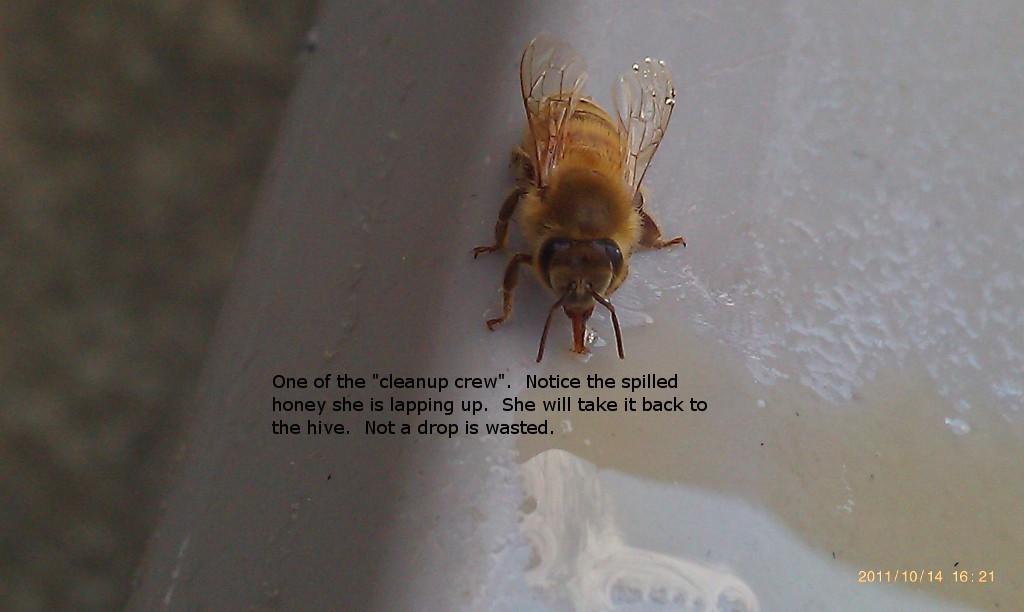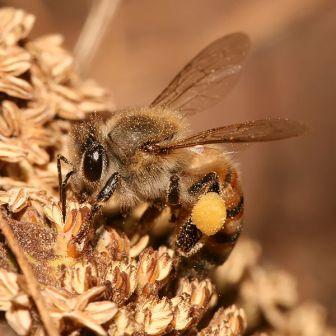It looks like you're using an Ad Blocker.
Please white-list or disable AboveTopSecret.com in your ad-blocking tool.
Thank you.
Some features of ATS will be disabled while you continue to use an ad-blocker.
share:
reply to post by Druid42
Vomit? Really?
I don't know what I thought was happening...but you see bees crawling around flowers...and pollen collects on their legs....somehow I thought that was how they did it
What is the purpose of the pollen covered legs?
Vomit? Really?
I don't know what I thought was happening...but you see bees crawling around flowers...and pollen collects on their legs....somehow I thought that was how they did it
What is the purpose of the pollen covered legs?
reply to post by DontTreadOnMe

Bees have fine hairs all over their bodies, that the pollen collects on. On their legs, they have "pollen baskets", much like we would use a backpack, and they collect the pollen to take back to the hive. Plants produce nectar to attract bees, and while the bee is foraging, they take a bit of nectar (very sticky), and mix it with the pollen, and then affix it to their legs.
A bee with pollen collected on their legs is a good sign, showing both healthy bees, and a viable pollen source.
If you see a bee like that, please, leave it alone. It's gonna take all that pollen back to it's hive to make more honey.

Bees have fine hairs all over their bodies, that the pollen collects on. On their legs, they have "pollen baskets", much like we would use a backpack, and they collect the pollen to take back to the hive. Plants produce nectar to attract bees, and while the bee is foraging, they take a bit of nectar (very sticky), and mix it with the pollen, and then affix it to their legs.
A bee with pollen collected on their legs is a good sign, showing both healthy bees, and a viable pollen source.
If you see a bee like that, please, leave it alone. It's gonna take all that pollen back to it's hive to make more honey.
Druid -
Great thread. Love the pictures! I've only been keeping bees for 4 years but everything you've posted is right on. I lost 50% of my hives over the last year but am now back to full strength. You and your Dad look like responsible and caring beekeepers, which is what is most needed. Thanks again and keep up the good work of educating the masses!
Great thread. Love the pictures! I've only been keeping bees for 4 years but everything you've posted is right on. I lost 50% of my hives over the last year but am now back to full strength. You and your Dad look like responsible and caring beekeepers, which is what is most needed. Thanks again and keep up the good work of educating the masses!
reply to post by Druid42
I knew you'd be able to give me an answer I've always been curious...but it would slip my mind by the time I would be back at the computer.
As this is about declining bee populations....I'm getting concerned.
Normally at this time of year, my perennial salvia and Coreopsis are abuzz with the little guys....this year it is almost scary ...for the first time in my garden...since 2000.
In fact, what I plant as flowers is intentional, both for the bees and then the seed pods of the Coreopsis for the finches to feast.
Is there anything I can do in a small suburban garden setting??
I've read about Blue Mason bees and small hives/homes you can attach to fences, etc.
www.masonbeehomes.com...
I knew you'd be able to give me an answer I've always been curious...but it would slip my mind by the time I would be back at the computer.
As this is about declining bee populations....I'm getting concerned.
Normally at this time of year, my perennial salvia and Coreopsis are abuzz with the little guys....this year it is almost scary ...for the first time in my garden...since 2000.
In fact, what I plant as flowers is intentional, both for the bees and then the seed pods of the Coreopsis for the finches to feast.
Is there anything I can do in a small suburban garden setting??
I've read about Blue Mason bees and small hives/homes you can attach to fences, etc.
www.masonbeehomes.com...
Originally posted by DontTreadOnMe
reply to post by Druid42
As this is about declining bee populations....I'm getting concerned.
Normally at this time of year, my perennial salvia and Coreopsis are abuzz with the little guys....this year it is almost scary ...for the first time in my garden...since 2000.
In fact, what I plant as flowers is intentional, both for the bees and then the seed pods of the Coreopsis for the finches to feast.
Is there anything I can do in a small suburban garden setting??
I've read about Blue Mason bees and small hives/homes you can attach to fences, etc.
www.masonbeehomes.com...
Not to answer your question on Druids' behalf, but I am also concerned not with just the domestic honey bee populations, but pollinators like their native counterparts and other insects affected by monocropping with help from trans-GMO technology and the use of chemicals in agriculture:
Results
Herbicide-resistant crop technology has led to a 239 million kilogram (527 million pound) increase in herbicide use in the United States between 1996 and 2011, while Bt crops have reduced insecticide applications by 56 million kilograms (123 million pounds). Overall, pesticide use increased by an estimated 183 million kgs (404 million pounds), or about 7%.
Conclusions
Contrary to often-repeated claims that today’s genetically-engineered crops have, and are reducing pesticide use, the spread of glyphosate-resistant weeds in herbicide-resistant weed management systems has brought about substantial increases in the number and volume of herbicides applied. If new genetically engineered forms of corn and soybeans tolerant of 2,4-D are approved, the volume of 2,4-D sprayed could drive herbicide usage upward by another approximate 50%. The magnitude of increases in herbicide use on herbicide-resistant hectares has dwarfed the reduction in insecticide use on Bt crops over the past 16 years, and will continue to do so for the foreseeable future.
EnvEurope - Impacts of genetically engineered crops on pesticide use in the U.S. -- the first sixteen years
This is a question for a full spectrum ecological study(s) to be done.
See Pollinator Decline
new topics
-
Zionists of ATS assemble
Political Issues: 3 hours ago -
For Votes - President BIDEN Opens ObamaCare Health Ins to Illegal Aliens Eff Nov 1st 2024.
2024 Elections: 8 hours ago -
EPA sues San Francisco for dumping billions of gallons of sewage into Pacific Ocean
US Political Madness: 9 hours ago -
Prophets versus priests; - Getting God's help
Religion, Faith, And Theology: 10 hours ago
top topics
-
Wounded Orangutan seen using a Plant as Medicine for the First Time
Fragile Earth: 14 hours ago, 17 flags -
Study Finds The More Covid Vaccine Doses You Have, the More Likely You Are to Get Covid
Medical Issues & Conspiracies: 13 hours ago, 14 flags -
Farmers jailed without due process
General Conspiracies: 15 hours ago, 10 flags -
EPA sues San Francisco for dumping billions of gallons of sewage into Pacific Ocean
US Political Madness: 9 hours ago, 9 flags -
UN Estimates Rebuilding Gaza Will Cost Up To 40 Billion Dollars
Middle East Issues: 13 hours ago, 8 flags -
For Votes - President BIDEN Opens ObamaCare Health Ins to Illegal Aliens Eff Nov 1st 2024.
2024 Elections: 8 hours ago, 8 flags -
Democratic Rep. Henry Cuellar and wife indicted on federal bribery charges
US Political Madness: 14 hours ago, 6 flags -
SEC shuts down Trump Media auditor, BF Borgers, over fraud
Mainstream News: 15 hours ago, 5 flags -
An AI-controlled fighter jet took the Air Force leader for a historic ride
Military Projects: 14 hours ago, 4 flags -
Zionists of ATS assemble
Political Issues: 3 hours ago, 3 flags

